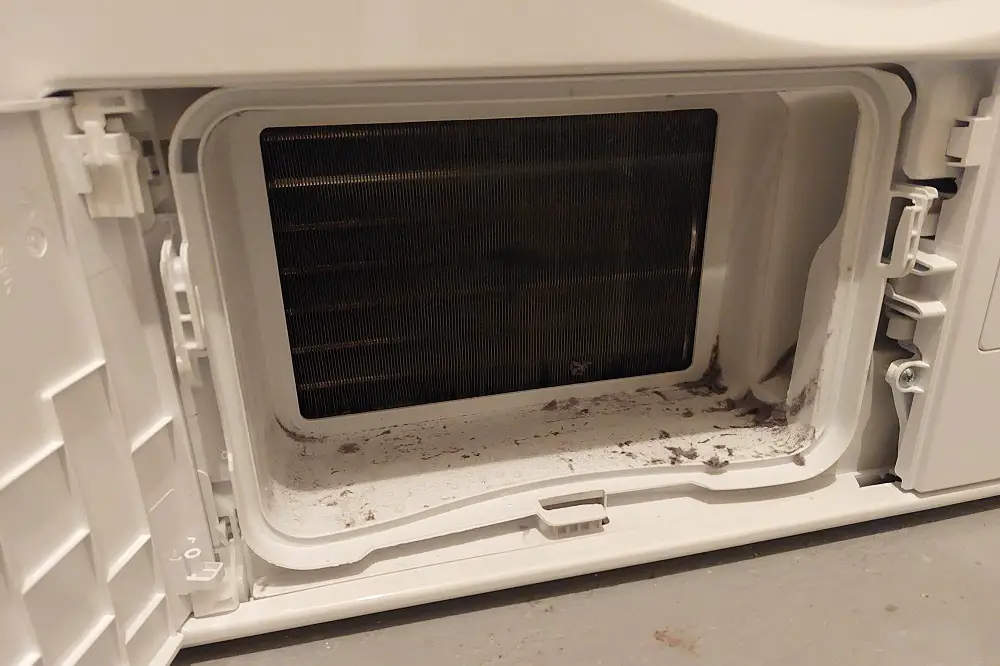The drying process in a tumble dryer can get tricky when it comes to sensitive materials like wool or other delicates. Using a spin dryer avoids using heat but applies high forces with rpm over 3000 which leads to the question if spin drying is dangerous to clothes.
If you use the appropriate spin speed for different types of laundry, you won’t see any damage to your laundry at all. Most modern washing machines have different wash-cycle options and spin speeds to suit different fabrics.

Table of Contents
4 Risks of Spin Dry
Drums with high speeds apply strong centrifugal force to the laundry. This process is highly efficient and can reduce the drying time to 5%. But it can have some negative impact if the items are too sensitive and take damage when compressed.
Some fabrics must only be spin-dried at lower spin speeds, while other fabrics can withstand high spin speeds without undergoing any damage.
Here are the 4 risks of spin-drying:
1. Tangled Laundry
If the laundry isn’t evenly distributed in the spin dryer or washing machine drum, your clothes could end up tangled when you take them out. In the process of de-tangling your laundry, you might cause damage to some of the clothes.
This is especially true for delicates that shouldn’t be stretched too much. If they are mixed with some heavy items they can easily tangle up.
2. Stretching of Clothes
Spin drying uses centrifugal force rather than heat to dry clothes. The high spin speed can stretch some fabrics, causing damage to such clothes.
Always refer to the wash care label of your garments before spin-drying to avoid stretch or even shrinking during washing and drying.
3. Using a High Spin Speed for Delicate Items
Generally, more delicate fabrics require a lower spin speed. The best spin speed for wool and synthetics is 800 RPM, while cotton can be spun at higher spin speeds of up to 1400 RPM. Delicate items need nothing faster than 600 RPM.
When you exceed the recommended maximum spin speed for the fabric type, the chances of damage to clothes are higher.
Most washing machines have different wash cycle options for different fabrics, with appropriate spin speeds to suit the fabric type. It’s best to sort the fabrics to suit the wash cycle you’ll be selecting.
4. A Damaged Spin
If the spin dryer or washing machine has a damaged spin or drum, the fabrics can get caught in the gaps, causing tears. One of the causes of such damage is when buttons, zips, or other forgotten metal objects bang on the sides of the inner drum.
While washing machine manufacturers make sure the drum itself can’t shift out of its position even at maximum speeds, faulty bearings or other parts, or general wear and tear can cause the machine to have a damaging spin.
Washing Symbol for Do Not Spin Dry
There is no specific washing symbol for ‘do not spin dry.’
However, many other washing symbols indirectly imply the same, like the ones listed below:
 |  |  |  |
| Hand Wash | Do Not Wash | Do Not Wring | Drip Dry |
When NOT to Spin Dry
With different wash cycle options in washing machines, it’s relatively safe to spin dry most types of fabrics, provided the suitable cycle is selected.
However, to make some of your clothes last a bit longer, here’s a list of what is best, not spin-dried.
- Cashmere and Wool:
Spin drying can cause tears, snags, and misshaping. - Silk:
Most silk items will have the care tag saying ‘dry clean only.’ Spinning silk in the dryer or washing machine may cause snagging, shrinking, and other damage. - Inner wear:
Inner garments with hooks may snag on other clothing in a spin dryer, and straps and bands may stretch out and lose shape. - Structured garments:
Items like pleated skirts, fitted pantsuits, and jackets and suits with shoulder pads may become distorted in a spin cycle. - Leather:
Leather items must never be washed, let alone spin dry. - Clothing with embellishments:
Items with intricately beaded embroidery or sewn-on sequins must only be hand-washed and not put in the spin dryer.
Does Spin Dry Shrink Clothes?
The fact that spin-drying shrinks clothes is half true. While a gentle spin cycle will keep the fabric of your clothes in shape, the longer the spin cycle, the more likely the clothes will get agitated and shrink.
Putting things made of wool on faster spin speeds will certainly shrink the clothes.
Higher speeds won’t cause any shrinkage to bedding or regular cotton shirts.
Some dryers have a ‘tumble’ setting that will spin-dry your clothes without using heat. Generally, the longer the clothes are in the machine, the more likely they will get agitated and potentially shrink.
Always check the care label of your clothes to avoid shrinking in the machine.
You should also check our article: Does A Tumble Dryer Shrink Clothes? (And How To Avoid It)
Can Spin Dry Damage Clothes?
Unlike tumble dryers which may cause damage to clothes because of the heat, spin dryers are less likely to damage clothes.
Apart from the items of clothing mentioned in the ‘When NOT to spin dry’ section above, if you select the correct setting, spin drying won’t damage your clothes.
Cotton and bulky items like denim, bedding, and towels can be dried using high-spin speeds since they can handle the speed of a high-spin cycle. When you mix heavy clothing with delicates on a high-spin speed cycle, you’ll may see some damage to them.
Conclusion
Air drying by hanging your washed laundry on a rack or washing line might be the most energy-efficient and safe way to dry any laundry. But spin drying is also an energy-efficient technique when compared to tumble drying.
Spin drying in a dryer or with high speeds in the washing machine is generally safe if the correct spin speed is chosen for the different types of fabrics. It is best to avoid using a spin dryer to dry cashmere, wool, silk, innerwear, structured garments, leather, and clothes with embellishments.
Also, it’s best to avoid spin drying clothes that have a hand wash, do not wash, do not wring, or drip dry washing symbols on their care label.



